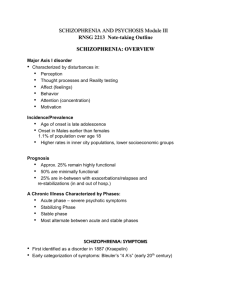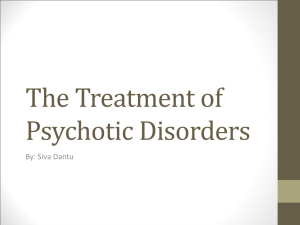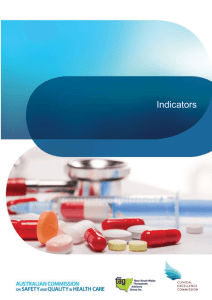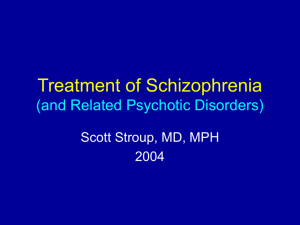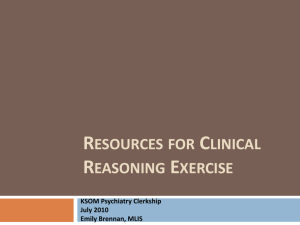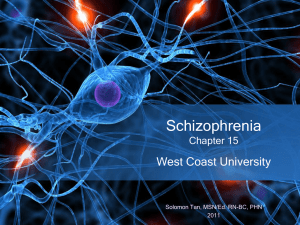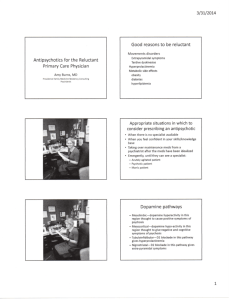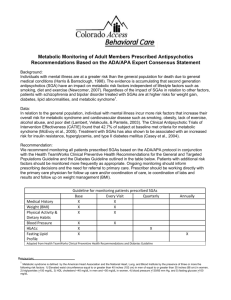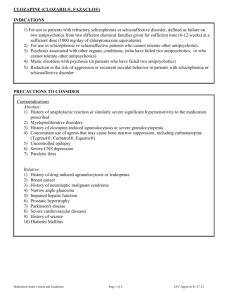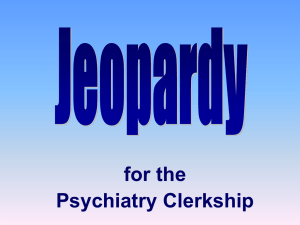Recommendations regarding management (monitoring) of side effects
advertisement
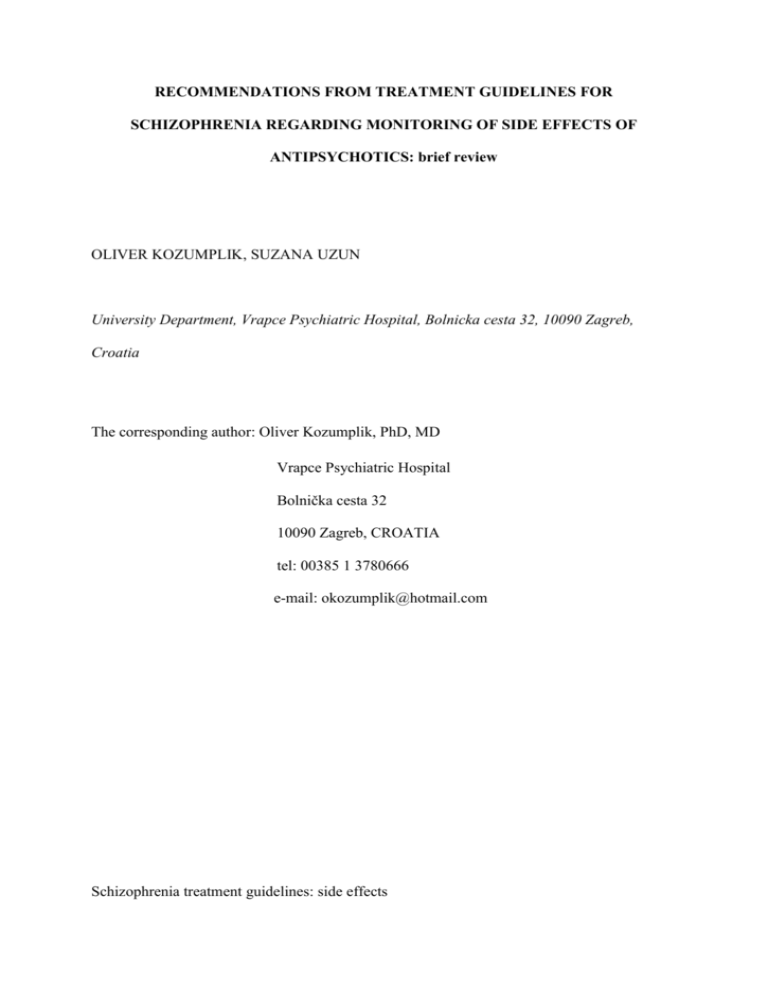
RECOMMENDATIONS FROM TREATMENT GUIDELINES FOR SCHIZOPHRENIA REGARDING MONITORING OF SIDE EFFECTS OF ANTIPSYCHOTICS: brief review OLIVER KOZUMPLIK, SUZANA UZUN University Department, Vrapce Psychiatric Hospital, Bolnicka cesta 32, 10090 Zagreb, Croatia The corresponding author: Oliver Kozumplik, PhD, MD Vrapce Psychiatric Hospital Bolnička cesta 32 10090 Zagreb, CROATIA tel: 00385 1 3780666 e-mail: okozumplik@hotmail.com Schizophrenia treatment guidelines: side effects SUMMARY The objective of this paper is to review therapeutic ways of management of antipsychotics' side effects. In order to obtain this, modern guidelines were investigated, as well as recent articles on this subject. Guidelines recommend that side effects should be monitored regularly, and the side effect profile of the prescribed antipsychotic should be considered. In case of unacceptable side effects, changing to a different antipsychotic is recommended. Key words: side effects, schizophrenia, antipsychotic, treatment INTRODUCTION Evidence based psychiatry and treatment guidelines have a significant role in raising the quality of mental health care and treatment, as well as in providing order where chaos reigns. The purpose of treatment guidelines and algorithms is to provide psychiatrists, health authorities, patients and their families with best evidence for making treatment decisions (1). Monitoring of side effects of antipsychotic is a part of everyday clinical practice, and although our knowledge about side effects has increased, clinicians are faced daily with this problem, and being forced to find options on the management of different side effects and their imapact on health, patients' functioning, quality of life and treatment compliance. The objective of this paper is to review therapeutic ways of management of antipsychotics' side effects. In order to obtain this, modern guidelines were investigated, as well as recent articles on this subject. METHODS OF LITERATURE RESEARCH Literature research included recomendations regarding management (monitoring) of side effects of antipsychotics from modern algorithms for treatment of schizophrenia and recent articles on this subject. Recommendations regarding management (monitoring) of side effects of antipsychotics from the following guidelines were considered: American Psychiatric Association. Practice guideline for the treatment of patients with schizophrenia, 2nd ed. (APA 2004). (2) Royal Australian and New Zealand College of Psychiatrists clinical practice guidelines for the treatment of schizophrenia and related disorders. Royal Australian and New Zealand College of Psychiatrists Clinical Practice Guidelines Team for the Treatment of Schizophrenia and Related Disorders (RANZCP 2005). (3) Canadian Psychiatric Association Working Group Members. Clinical Practice Guidelines Treatment of Schizophrenia, 2005. (4) National Institute for Clinical Excellence. Guidance on the use of newer (atypical) antipsychotic drugs for the treatment of schizophrenia (NICE 2002). (5) CONTENT ANALYSIS OF GUIDELINES AND LITERATURE The investigated guidelines recommend that side effects should be monitored regularly (2-5). It is critical to assess continuing side effects that may have been present in the acute phase and to adjust pharmacotherapy accordingly to minimize adverse side effects that may otherwise lead to medication nonadherence and relapse. The available antipsychotic medications are associated with differential risk of a variety of side effects, including neurological, metabolic, sexual, endocrine, sedative, and cardiovascular side effects. Monitoring of side effects based on the side effect profile of the prescribed antipsychotic is warranted (2). Baseline MRI scan, neurocognitive assessment, neurological examination for neurological abnormalities and movement disorder, ECG, height and weight (BMI), illicit drug screen, lipid profile and fasting serum glucose (and/or HbA1c) are all part of optimal initial assessment (3). Regular and ongoing evaluations are equally necessary when patients respond to medications, when they fail to respond, and when they develop side effects. Standardized scales are useful tools for baseline and later assessments. During Stabilization Phase assessments should take place at least every 3 months to achieve optimal dosages and choice of antipsychotic medications and to monitor for drug-induced side effects (4). Sexual function and side-effects should be reviewed regularly and backed up by measurement of prolactin levels where indicated (3). While longer-term data are required, the limited evidence available clearly indicates that the atypical antipsychotics have a decreased liability of tardive dyskinesia, approximately 1% compared with 5% for typical agents annually (6). Like clozapine, the other atypical antipsychotics also demonstrate antidyskinetic properties in individuals with preexisting tardive dyskinesia (6). In the study that compared recent estimates of incidence and prevalence of TD identified with some modern APDs to the epidemiology of TD in the earlier neuroleptic era, available evidence suggested that the risk of TD may be declining, but longitudinal studies of patients never treated with traditional neuroleptics and exposed to only a single modern APD are required to quantify TD risks with specific drugs (7). During the stable phase of treatment it is important to routinely monitor all patients treated with antipsychotics for extrapyramidal side effects and the development of tardive dyskinesia (2). 6 monthly examination for signs of tardive dyskinesia should be carried out (3). Increasing numbers of reports concerning diabetes, ketoacidosis, hyperglycaemia and lipid dysregulation in patients treated with second-generation (or atypical) antipsychotics have raised concerns about a possible association between these metabolic effects and treatment with these medications (8). Weight gain occurs with most antipsychotic agents. Up to 40% of patients treated with FGAs gain weight, with the greatest risk associated with the low-potency antipsychotics (9). While demonstrating several advantages over first-generation antipsychotics, second-generation antipsychotics have been found to cause or exacerbate several metabolic disorders, including diabetes, obesity, dyslipidemia, and metabolic syndrome. These disorders are closely linked and consistently associated with the development of cardiovascular disease, with varying prevalence rates depending on the second-generation antipsychotic used (10). In general, the rank order of risk observed for the second-generation antipsychotic medications suggests that the differing weight gain liability of atypical agents contributes to the differing relative risk of insulin resistance, dyslipidaemia and hyperglycaemia. From this perspective, a possible increase in risk would be predicted to occur in association with any treatment that produces increases in weight and adiposity. However, case reports tentatively suggest that substantial weight gain or obesity may not be a factor in up to one-quarter of cases of new-onset diabetes that occur during treatment (8). Because of the risk of weight gain associated with many antipsychotics, regular measurement of weight and body mass index (BMI) is recommended. Routine monitoring for obesity-related health problems (e.g., high blood pressure, lipid abnormalities, and clinical symptoms of diabetes) and consideration of appropriate interventions are recommended particularly for patients with BMI in the overweight and obese ranges. Clinicians may consider regular monitoring of fasting glucose or hemoglobin A1c levels to detect emerging diabetes, since patients often have multiple risk factors for diabetes, especially patients with obesity (2). Weight and BMI should be measured at the start of treatment, then monthly for 6 months and 3 monthly thereafter. Consultation with a dietician is advisable as is encouragement of regular exercise. Finally it may be necessary to consider a medication with a lower risk of weight gain if this does not respond or is marked. Fasting plasma glucose (or HbA1c) and lipid profile should be measured at baseline and at regular intervals during the course of treatment, along with other investigations as indicated (3). In the investigation that aimed to assess the diagnostic properties of 2 different screening guidelines for the detection of diabetes in patients diagnosed with schizophrenia, the sensitivity of 2 screening strategies was compared with the "gold standard": the OGTT. The 2 strategies were (1) assessing fasting glucose in all patients, as suggested by the American Psychiatric Association/ American Diabetes Association (APA/ADA), and (2) a screening strategy derived from the guidelines of the World Health Organization of assessing fasting glucose in all patients (step 1) and subsequently performing an OGTT in patients with impaired fasting glucose (step 2). The guidelines to detect diabetes as proposed by the APA/ADA did not sufficiently detect diabetes in this specific high-risk group. The alternative 2-step strategy was able to detect the vast majority of diabetes cases and should therefore be considered in the clinical routine of screening and monitoring patients with schizophrenia (11). Several management options of weight gain are available from choosing or switching to another drug, dietary advices, increasing physical activities, behavioural treatment, but the best approach seems to attempt to prevent the weight gain: patients beginning maintenance therapy should be informed of that risk, and nutritional assessment and counselling should be a routine part of treatment management, associated with monitoring of weight, BMI, blood pressure, biological parameters (baseline and three months monitoring of fasting glucose level, fasting cholesterol and triglyceride levels, glycosylated haemoglobin) (12). The experts stressed the importance of monitoring for health problems-especially obesity, diabetes, cardiovascular problems, HIV risk behaviors, medical complications of substance abuse, heavy smoking and its effects, hypertension, and amenorrhea-in patients being treated with antipsychotics (13). An article that reviewed the major published consensus guidelines for metabolic monitoring of patients treated with antipsychotic medications and selectively reviewed practice guidelines for the management of diabetes, dyslipidemia, and hypertension showed considerable consensus in the published guidelines. Areas of dissent included which patients to monitor, the utility of glucose tolerance testing, and the point at which to consider switching antipsychotics (14). If, with conventional antipsychotics, side effects are troublesome or symptom control is inadequate, an atypical should be offered. If conventional antipsychotics have been used and are not effective or are causing unacceptable side effects, it is recommended to change to an atypical antipsychotic. If an atypical is causing diabetes or excessive weight gain, this must be monitored or consider changing to a different atypical or a conventional antipsychotic (5). By routinely performing physical health monitoring, referrals, and/or treatment for patients with schizophrenia and other forms of severe mental illness, mental health care providers can take a lead role in transforming the current system of fragmented mental and physical health services into a system focused on early intervention, wellness, and recovery (10). Understanding of the side effects of psychotropic drugs, including their metabolic consequences (weight gain, diabetes, dyslipidemia) is essential for the psychiatrics to avoid on the one hand a risk of lack of compliance, a discontinuation of the pharmacological medication and also a risk of relapse and rehospitalization, and on the other hand to avoid acute life threatening events (diabetic ketoacidocetosis and non ketotic hyperosmolar coma, long term risk complications of diabetes and overweight) (12). CONCLUSION Guidelines recommend that side effects should be monitored regularly, and the side effect profile of the prescribed antipsychotic should be considered. In case of unacceptable side effects, changing to a different antipsychotic is recommended. REFERENCES 1. Jakovljevic M: Myths and facts in contemporary psychopharmacotherapy: evidence-based vs. evidence-biased treatment algorithms practice. Psychiatr Danub 2007; 19(4):342-49. 2. American Psychiatric Association: Practice guideline for the treatment of patients with schizophrenia. 2nd ed. Am J Psychiatry 2004; 161(2):1-114. 3. Royal Australian and New Zealand College of Psychiatrists Clinical Practice Guidelines Team for the Treatment of Schizophrenia and Related Disorders: Royal Australian and New Zealand College of Psychiatrists clinical practice guidelines for the treatment of schizophrenia and related disorders. Australian and New Zealand Journal of Psychiatry 2005; 39:1–30. 4. Canadian Psychiatric Association Working Group Members: Clinical Practice Guidelines Treatment of Schizophrenia. Can J Psychiatry 2005; 50 (1). 5. National Institute for Clinical Excellence: Guidance on the Use of Newer (Atypical) Antipsychotic Drugs for the Treatment of Schizophrenia. Technology Appraisal Guidance 43. London: NICE, 2002. 6. Remington G: Tardive dyskinesia: eliminated, forgotten, or overshadowed? Curr Opin Psychiatry 2007; 20(2):131-7. 7. Tarsy D & Baldessarini RJ: Epidemiology of tardive dyskinesia: is risk declining with modern antipsychotics? Mov Disord. 2006; 21(5):589-98. 8. Newcomer JW: Second-generation (atypical) antipsychotics and metabolic effects: a comprehensive literature review. CNS Drugs 2005; 19(1):1-93. 9. Kane JM & Lieberman JA: Adverse Effects of Psychotropic Drugs. New York: Guilford, 1992. 10. Sernyak MJ: Implementation of monitoring and management guidelines for secondgeneration antipsychotics. J Clin Psychiatry 2007; 68(4):14-8. 11. van Winkel R, De Hert M, Van Eyck D, Hanssens L, Wampers M, Scheen A & Peuskens J: Screening for diabetes and other metabolic abnormalities in patients with schizophrenia and schizoaffective disorder: evaluation of incidence and screening methods. J Clin Psychiatry 2006; 67(10):1493-500. 12. Ruetsch O, Viala A, Bardou H, Martin P & Vacheron MN: Psychotropic drugs induced weight gain: a review of the literature concerning epidemiological data, mechanisms and management. Encephale 2005; 31(4 Pt 1):507-16. 13. Kane JM, Leucht S, Carpenter D, Docherty JP; Expert Consensus Panel for Optimizing Pharmacologic Treatment of Psychotic Disorders: The expert consensus guideline series. Optimizing pharmacologic treatment of psychotic disorders. Introduction: methods, commentary, and summary. J Clin Psychiatry 2003; 64(12):5-19. 14. Cohn TA & Sernyak MJ: Metabolic monitoring for patients treated with antipsychotic medications. Can J Psychiatry 2006; 51(8):492-501.
